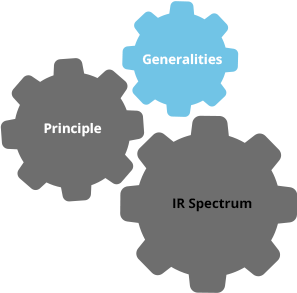Generalities
IR spectroscopy is based on the absorption by the sample of a light beam whose radiations are divided into three ranges:
- Near-infrared
- Mid-infrared
- Far-infrared
IR ranges and types of movements observed
(click on each range for more details)
In the far-IR range, pure rotations of molecules in their gaseous form are mainly observed. Their interpretation remains difficult and often requires numerical simulation.
Mid-IR spectroscopy is the most common and provides access to the identification of chemical functions in a molecule.
In the near-IR, the wide and low-intensity bands observed correspond to combinations and overtones of vibrational modes. The applications of these analyses, found in quality control, often require data processing by chemometrics.






